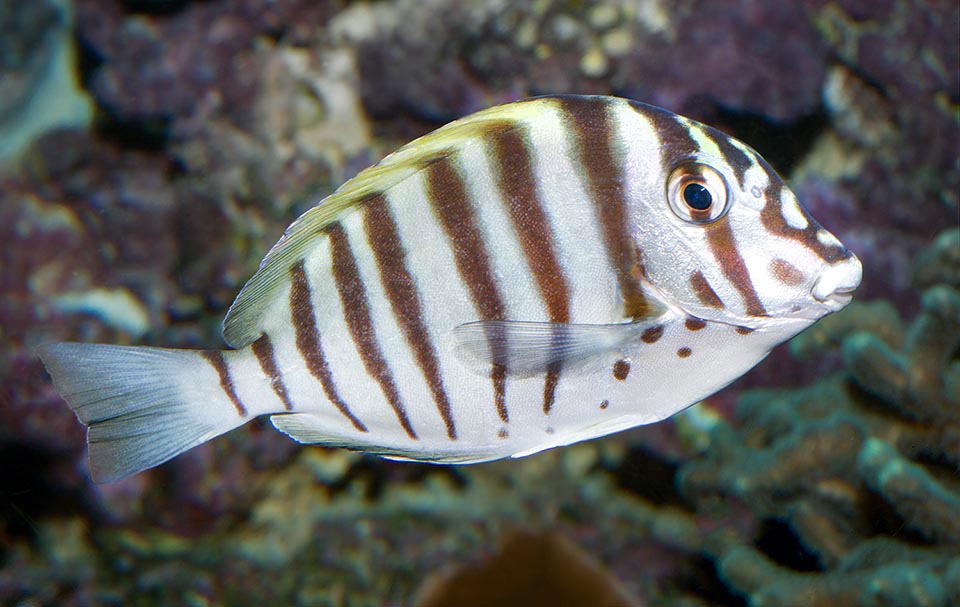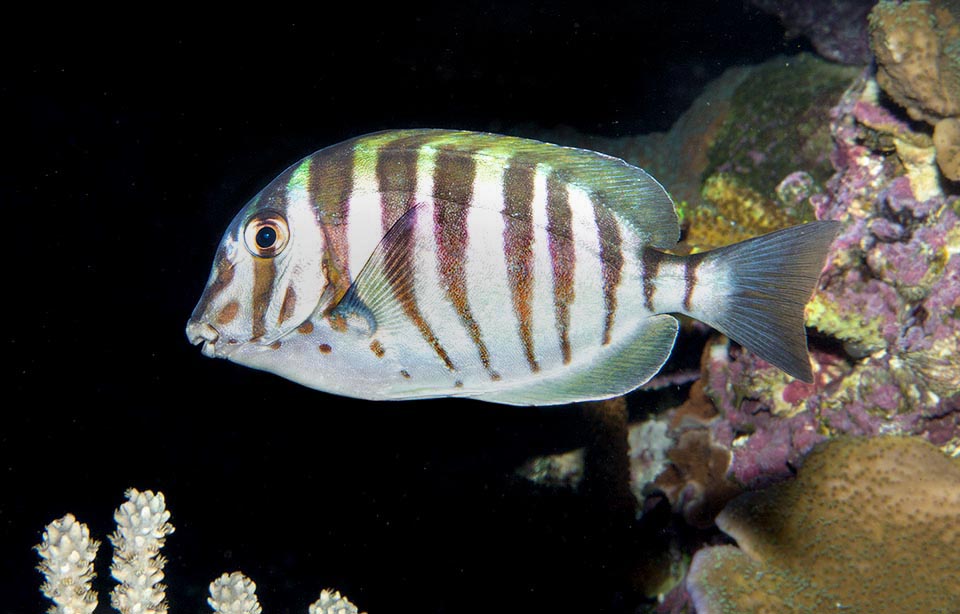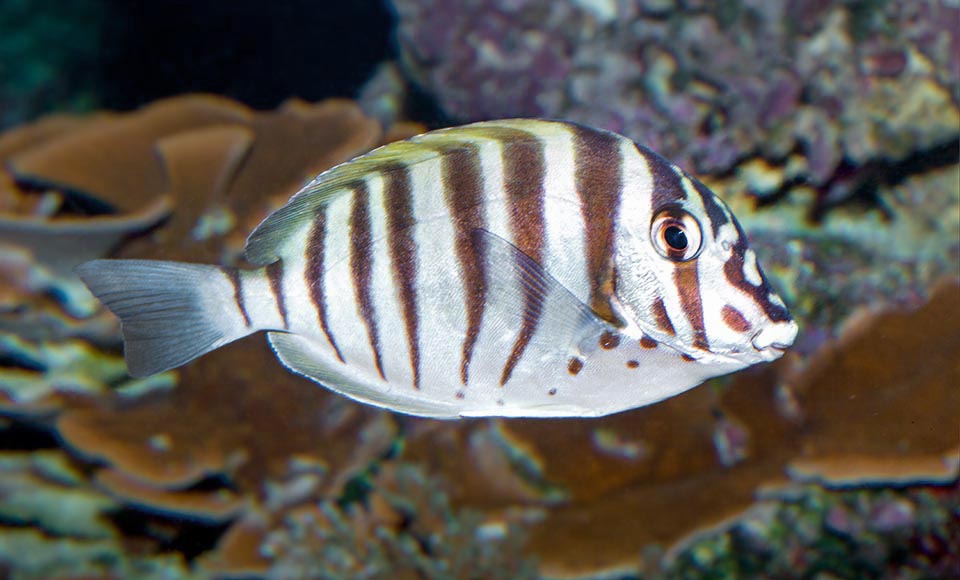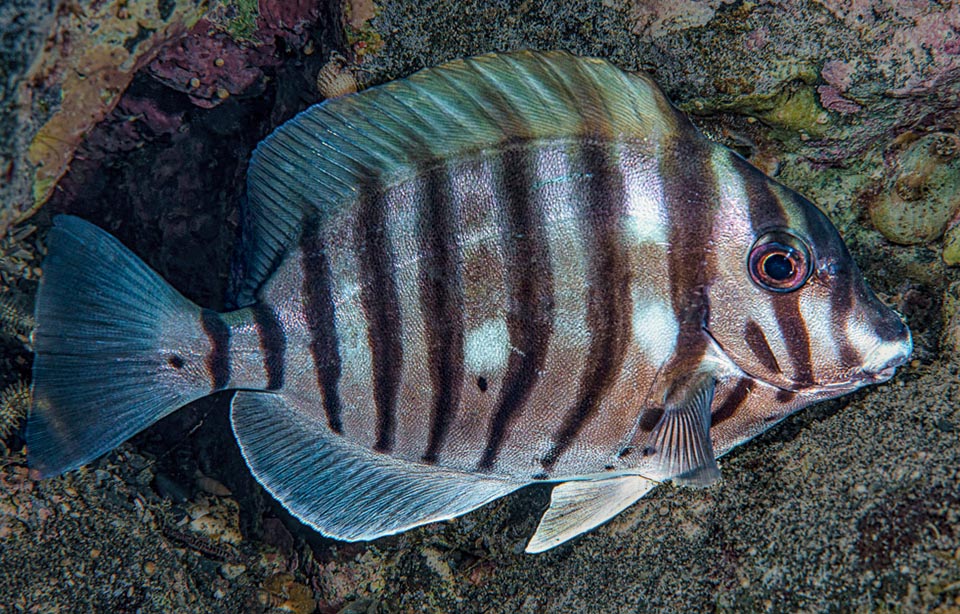Family : Acanthuridae

Text © Giuseppe Mazza

English translation by Mario Beltramini

The Acanthurus polyzona lives, very localized, only in western Indian Ocean: Comoros, Madagascar, Réunion, Mayotte and Mauritius © Giuseppe Mazza
The Black-barred surgeonfish (Acanthurus polyzona Bleeker, 1868), belongs to the class Actinopterygii, the ray-finned fishes, to the order of the Perciformes and to the family of the Acanthuridae.
The name of the genus Acanthurus comes from the Greek “akantha”, thorn, and “ura” = tail, due to the sharp spine these fishes have on the sides of the caudal peduncle. The name of the species polyzona, comes from the Greek “polys“= many, and from the Latin “zona” = girdle, belt, due to the numerous and characteristic dark vertical bands.
Zoogeography
It lives, very localized, only in the western Idian Ocean. We find it at the Comoros Archipelago, along the coasts of Madagscar and at Réunion, Mayotte and Mauritius Islands.

Poorly studied, swims in shallow waters among rocks covered by weeds and corals, but also in the tidal zone among mangroves roots © Giuseppe Mazza
Ecology-Habitat
It goes swimming in shallow waters, never under the 15 m of depth, among rocks covered by weeds and corals, but also in the tidal zone among the roots of the mangroves.
Morpho-Physiology
It usually does not exceed the length of 11 cm, though some people talk of 20 cm. The relatively flat, short and angled, more rhomboidal than oval with spread fins, shows a protruding front that goes down almost vertically. As a whole, it looks much like the Acanthurus triostegus, so much that they had talked of a subspecies, even if decidedly smaller with almost the double of vertical bands. In fact, on the body we count 8 of them, starting from the caudal peduncle, plus a broken one that crosses the eye not to forget the fragmented drawings on the muzzle.

Usually does not exceed the 11 cm, less than half than similar Acanthurus triostegus, but with an almost double number of vertical bands © Giuseppe Mazza
The dorsal fin has 9 spiny rays and 25-25 soft. The anal is symmetric but somewhat shorter, with 3 spiny rays and 21-23 unarmed rays. The pectoral fins count 16 rays and the caudal is trimmed. The jaws of the adults have 19 small teeth above and 20 below. The background colour is silvery white, paler ventrally where the vertical belts get thinner, trasnforming in roundish spots towards the head. The dorsal fin and the nearby zones show yellowish shades, like in the Acanthurus triostegus.
The sharp blade on the caudal peduncle is surely little visible. It is not emphasized because these small fishes do not need it, in fact they primarily play the mimetic card in their survival strategies.
Ethology-Reproductive Biology
Seen the modest diffusion and the absence of studies or monitorings, little is exactly known on the species that has a feeding, probably based, as for Acanthurus triostegus, on the filamentous algae and the plankton.

The zebra livery, mimetic during the day in the reef’s light and shade, is no longer such in the dark, and then the white fades as documented by this rare night photo © François Libert
It is well known that the males show a courting livery, that the fecundated eggs and the larvae are planktonic. From observations carried out after the hurricane of 1989 at the Réunion Island, it seems that the populations had kept stable thanks to the excellent resilience of the species, that may double its membres in less than 15 months.
The Acanthurus polyzona is not fished for food purposes and even less required, due to the high cost and the modest look, by the aquarium market. Consequently, the fishing vulnerability index is very low, and marks just 10 on a scale of 100.
Synonyms
Rhombotides polyzona Bleeker, 1868; Acanthurus triostegus polyzona Bleeker, 1868.
→ For general information about FISH please click here.
→ For general information about BONY FISH please click here
→ For general information about CARTILAGINOUS FISH please click here.
→ To appreciate the BIODIVERSITY of BONY FISH please click here.
→ To appreciate the BIODIVERSITY of CARTILAGINOUS FISH please click here.
